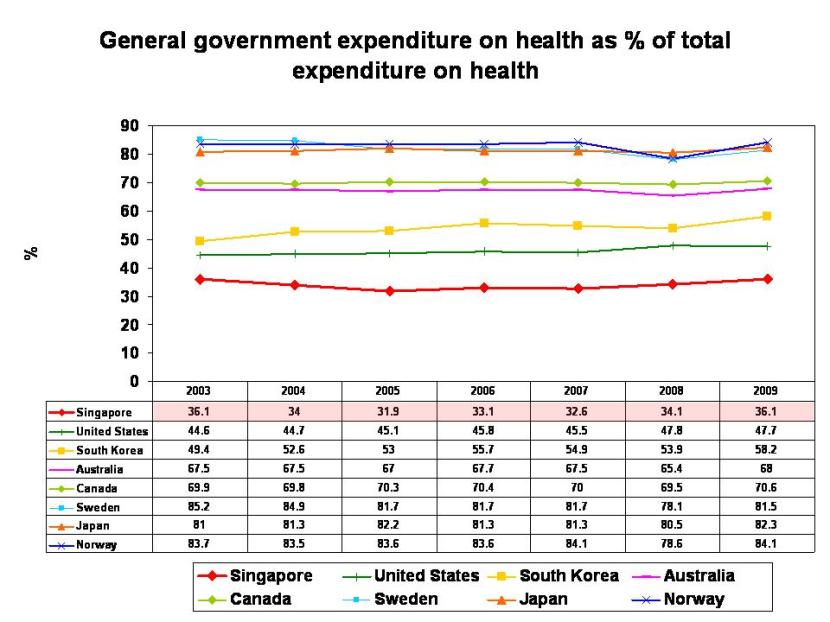Increasing Government’s Share of National Healthcare Spending to 40% – Big Deal?
Health Minister Gan Kim Yong had announced that, the government will increase its “share of national spending, to provide Singaporeans with greater assurance that care will remain affordable and accessible. Government spending will not only rise in tandem with the increase in national healthcare spending. We will in fact take on a greater share of national spending, from the current one-third to about 40 percent and possibly even further, depending on various factors such as demographics, and our ability to manage healthcare costs and target our subsidies. This will help to reduce the impact of rising healthcare costs on Singaporeans, especially the lower- and middle-income Singaporeans.”
Is the government’s increase of their proportionate expenditure on health to 40% a cause for celebration? Let’s do a quick comparison with some other countries to find out.
I looked at the countries with a similar economic development as Singapore and other countries which have healthcare systems which are ranked highly for comparison.
In Chart 1, you can see that Singapore allocates the lowest proportion of our GDP on healthcare. Whereas in South Korea and Japan, the proportion has been increasing since 2003, Singapore’s proportion has remained stagnant and even dropped in the middle years.
Chart 1
In Chart 2, you can see that Singapore’s proportionate government expenditure on health is actually the lowest, at 36.1% in 2009. Not only that, we’ve maintained a very low proportion over the years, whereas in United States and South Korea, the countries with the two lowest proportionate government expenditure after Singapore, they have increased their proportionate expenditure over the same period of comparison. In South Korea, this has risen by almost 10 percentage points from 2003 t0 2009. In fact, the proportionate government expenditure on health has declined all the way since Singapore’s independence. According to Mr Leong Sze Hian, “the share of public healthcare spending (has declined) from about 75 per cent in 1965 to about 33 (a third) per cent now,” which means that as our country became richer, the government started giving less to the people. In the Nordic countries and Canada, their governments pay for more than 80% of their healthcare bills.
Chart 2
On the flipside, you can see in Chart 3 that Singaporeans spend the highest proportionate expenditure out of our own pockets to pay for medical bills. We are required to fork out our own money to pay for more than 60% of our healthcare bills.
Chart 3
So, the government says that it would “in fact take on a greater share of national spending, from the current one-third to about 40 percent and possibly even further”. If you look at Chart 4, even if the government increases their proportionate expenditure to 40%, this will still be much lower than what the other governments are spending for their people.
Chart 4
It becomes even more glaring when you compare the proportionate government expenditure on health with the GDP per capita.
If you look at Chart 5, you can see that even though Singapore has the highest GDP per capita in the countries compared (and 6th among the 228 countries compared on CIA’s website), the government spends the lowest proportionate expenditure on health.
Chart 5
In fact, you can see that generally, the higher a country’s GDP per capita, the higher the proportionate government expenditure on health that the country is likely to spend for the people. This is not true only in two instances – first, even though Japan has a relatively low GDP per capita, the government spends a very high proportionate expenditure on health. At the other end of the spectrum, both the United States and Singapore has relatively high GDP per capita but their governments contribute the lowest proportionate expenditure on health.
This is significantly worse for Singapore which has the 6th highest GDP per capita among 228 countries, yet our government spends the lowest proportionate expenditure on health. With the GDP per capita that Singapore has, the government should spend at least contribute to 85% to our health expenses.
Yet, the government has decided to announce mightily that they will be increasing their proportionate expenditure to a puny 40%. This is nothing to shout about and is in fact disastrously embarrassing for a country which likes to thump its chest as having one of the world’s highest GDP per capita and wealth.
For a country that is so rich, we treat our people very poorly. 40% is nothing to shout about. If the government is truly sincere about making healthcare “affordable and accessible”, they should increase their proportionate government expenditure to at least 60%.
The health statistics are obtained from the World Health Organisations’s World Health Statistics, which can be found here.
The GDP per capita statistics are obtained from the CIA, which can be found here.






Good stuff and so succinctly put together. It’s also wonderful to see that you have also given credit to long-time blogger and activist Mr Leong Sze Hian who has been tirelessly trying to enlighten Singaporeans on how and why we are in this deep hole.
Surely outcomes are at least as important? This kind of article is like saying if I spend more of my personal budget on medicine, I must be healthier.
Not to mention that if I have more per capita GDP, surely I should be spending a smaller percentage on healthcare to produce the same outcome?
Hello blogger, i must say you have hi quality content here.
Your page can go viral. You need initial traffic only.
How to get it? Search for: Mertiso’s tips go viral